The C28 gravel road I am taking from Swakopmund to Windhoek is dry and tough: less than 10 cars use it every day, but it has very rewarding views. It is used by a MTB race called the Namib Quest, where cyclists take 6 days (like me) to cover the distance, but in the other direction. There is another event called the Desert Dash, taking a route slightly more southern, where cyclists race the 369 km from the capital to the coast in less than 24 hours.
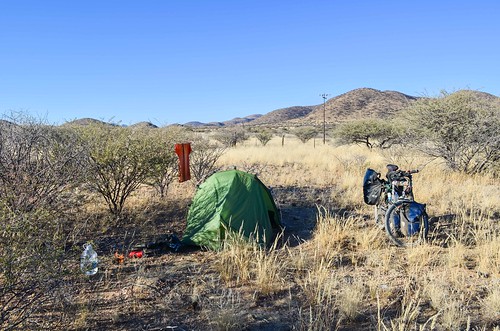
Going uphill and against the wind, and having no one to throw me food, water, and to set up my tent before I arrive, what I’m doing is not really easier. Now that I’m out of the Namib-Naulkuft desert, the surroundings are farm lands, and cows.
There is still some wind, and it’s still against me. Sigh … I have a chat with the driver of a 4×4 tour, who happens to pass in front of me just before I get on the saddle. “Where are you going?“, he asks. Well, I’m going to Windhoek via the Boshua pass. I also ask him if it’s possible to get food on the way.”Boshua is like this!”, he replies, showing me his hand almost vertically.”It takes 6 hours with a car, so it will take you at least two days with the bicycle. There’s no food on the way, nothing, absolutely nothing! Good luck!“. And there they go.
I doubt it takes 6 hours for a car to travel the remaining 180 km, but fore sure it will take me at least two days, probably three. And I will run out of food tonight. I was carrying 3 kg of spaghetti for 4 days, and it’s already my fourth day today. The wind delayed me a lot and the estimated 4 days won’t be enough. I’ve used almost all my spaghetti, cooked with a Maggi flavoring cube and BBQ sauce on top (to make them taste like pork ribs. It’s sad but it works …)

I still don’t understand why people keep warning me against this Boshua pass, or raising eyebrows when I talk about it. I am already at 1200 m high, and Windhoek being at 1700, I can’t imagine how it will be a difficult one. It’s certainly physically challenging because of the lack of everything for 300 km, but it can’t be impossible.
Just a few kilometers after starting my day, and 30 km before the pass, there is a crew of workers with a road grader. They live in a big trailer with bunk beds and spend days making the road surface very clean.
I ask them for food. There will surely be someone passing on this road before I die of hunger, but I’d rather eat every day if possible. The workers give me 500 g of macaroni, which buys me 12 hours of survival, and they add that there is a small shop by the road in 42 kilometers. Really? A shop there? That’s a big surprise. It’s an information to be taken with a pinch of salt, as I’ve yet to see someone on this continent who can talk about a distance in kilometers with a relative accuracy. Well, on the other hand, they are road graders, so they should know every turn of the road they are responsible for.
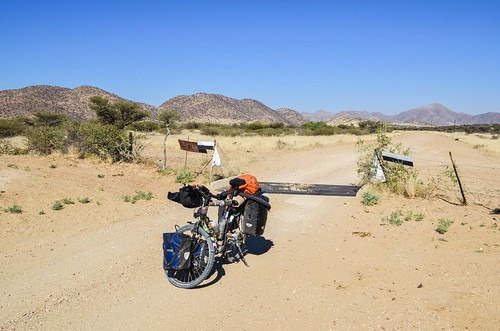
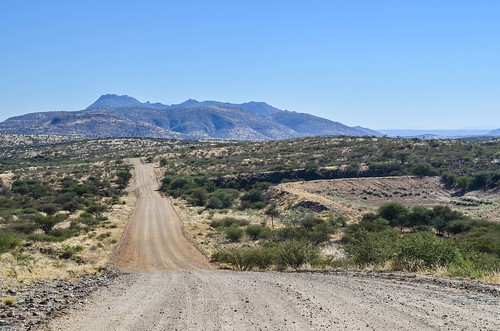
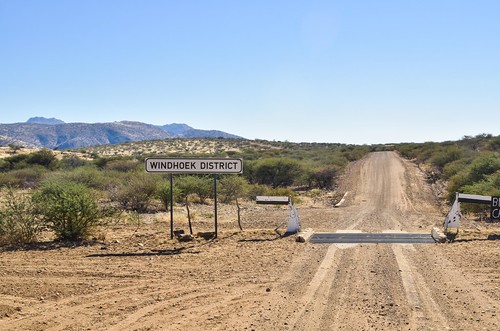
The road goes up and down around 1200 m, falling into dry river beds and climbing right after. Just before the Boshua pass, at 12, the second car of the day stops to offer me water. “We followed your bicycle tracks from Swakopmund and were wondering when we would meet you“, the two women greet me.
They have a farm on this road, and say all the farmhouses from now on will be too deep inland for me to fetch water, just like theirs, 10 km from the C28. I ask about hyenas, and they reply: “No, there are no hyenas around here. It’s safe, you can sleep anywhere. But don’t get too close to the Black people, they steal everything“. Well, I rarely see anyone by this road, and it’s even less likely that I will bump into Black people where all the farms are white-owned (or they would be working and living near a farmhouse). The only ones I have seen so far were the road graders, and they saved me with pasta.
They add that the hyenas of the region are not the dangerous specie anyway. But there are also jackals, and …plenty of leopards. They travel freely from farm to farm, but they won’t attack me. The farms have generally a cattle fence, just high enough to prevent the cows from escaping. One lady says she shoots these leopards. Aren’t they protected?
“Yes, they are protected, but if only the government knew what damage they are causing … We lose eleven calves every year on your farm (6000 ha). If you convert this to money …” I have also seen recently several news about Americans (or Spanish kings) blamed for shooting giraffes and lions in Africa. In that case, it’s not illegal, they must be going to some “hunting farms” in Southern Africa, where the White owner pays a license fee to the government, and receive a huge payment from the client per head. Obviously, the more scandalous killing that animal is, the higher the price. Although I don’t see the point of shooting a peaceful giraffe or an endangered rhino, this is the business of some farmers over here.

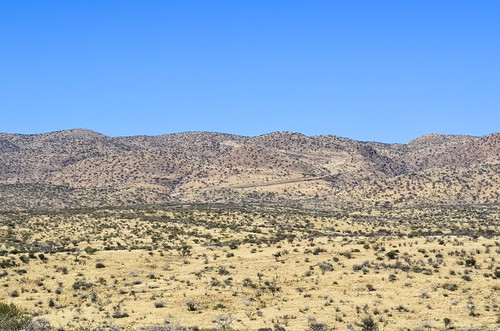
In the afternoon, I finally stop moving up and down in dry riverbeds to take on the real slopes. The Boshua pass is in front of me. It doesn’t look like anything terrific. Just a hill with shrubbery.
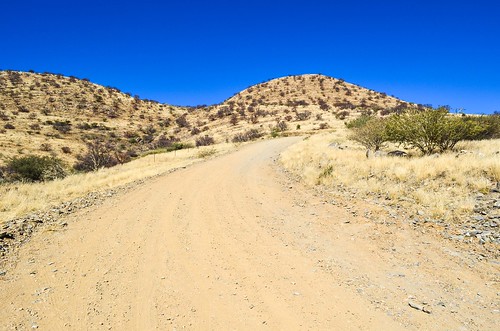
But as soon as I reach the first slope, I realize what it is all about. It’s probably not long, but it’s just too steep. Instead of making five or tens turns to pass over that hill, the road goes straight into the slope. I’m sure it’s impossible to cycle it while fully loaded, but more than that, it’s not guaranteed that you can push it uphill: you need muscles elsewhere than in the legs.

It’s a bit annoying that I didn’t manage to take a photo that reveals how steep these slopes are. Soon after the first one, I reach the second one. This one is paved with cobblestone at its steepest, which is at least 20%. Some people have died here because their cars were not powerful enough. I understand now why it is forbidden for trailers and why people looked at me strangely when I said I would cycle it up.
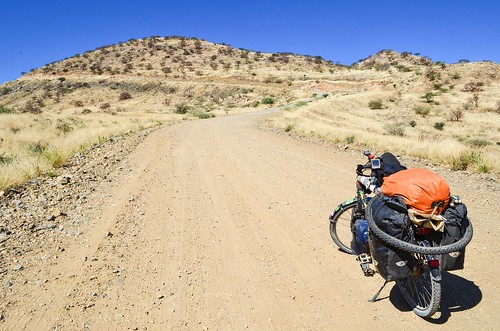
This is the kind of slope where you push the bicycle with your arms only, hold the brakes tight, and make a step forward (without slipping if it’s gravel). And repeat. No breaks allowed as the bike wouldn’t stand on the kick stand. It’s an exercise much closer to weightlifting than to cycling. The steep and cobblestoned part is short, only a hundred meters, but it’s enough to give a reputation to the whole road.
I would say the steepest is above 20%. It doesn’t seem much, but with a fully loaded bicycle on the arms, it weighs a lot. During the pushing, a man coming out of nowhere (apparently pitching fence posts) helps me for a minute, while I was thinking I should have made two trips, one for the bike and one for the panniers.


On the top of it, there’s a little shelter, which roof has apparently “been stolen“, and I try to catch the cellular signal. I saw one bar but it disappeared. I had no signal since 30 km after Swakopmund, and it won’t come back until 30 km before Windhoek. I was told it is possible to catch it on the top of certain hills, but you must know which ones.
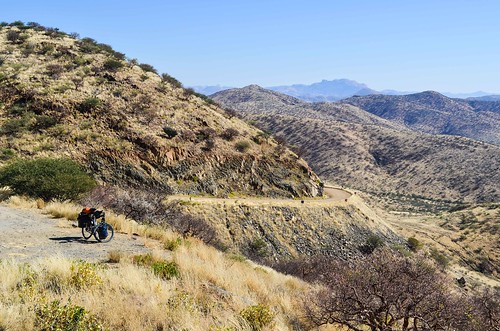
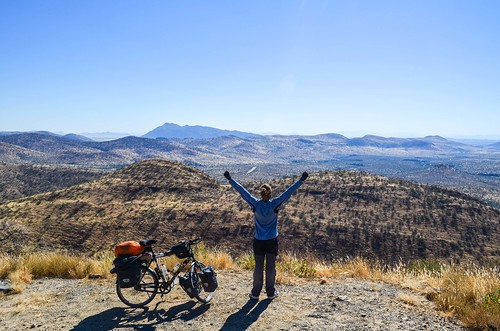
That steep part was awful, but it’s not the end yet. After a small turn, there is a third steep slope, now taking me up to 1700 m. I had clearly underestimated the difficulty of this C28. A 4×4 convoy is passing me downhill and offers me a cold beer. I naively ask if the pass is over yet, to which I am replied with a laugh “hahaha no. It’s up and down from now on. Good luck.”
And indeed, the worse is not pushing up the Boshua pass, but the 80 km long roller coaster that follows it. The landscape looks like the stripes I had in Damaraland, except that this time, the road tries to make the biggest elevation gain possible, going up and down as often as it can. From the sky, I must look like an ant travelling over the length of 100 stegosaurus at 100 meter per hour.

My legs are dead and the gravel is loose. As a result, I push at almost every ascent. The scenery is nice but I hardly enjoy it as I’m too tired and I can’t think of anything but food and water. I dream of capturing one of these warthogs that run around, and roasting an entire one over a fire tonight.
I’m hungry, not to the point of stopping one of the few cars as I still have some pasta in my panniers, but hungry enough to think of food all the time. I have nothing readily edible on me. This roller coaster hills never end and I feel terrible.
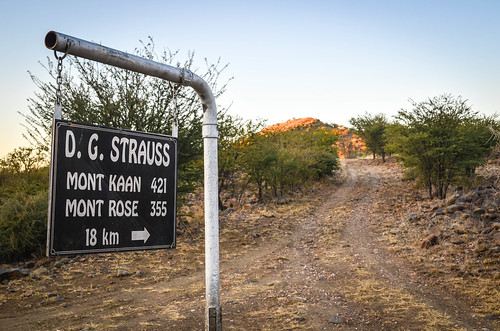
There’s nothing by the road but fences, cows, and a broken electricity line, as the farmers live withdrawn back in their farm, for “privacy and security” as I was explained. It’s unbelievable how everything is fenced, even on hills where the slopes and the rocks would not allow cows to pass anyway.
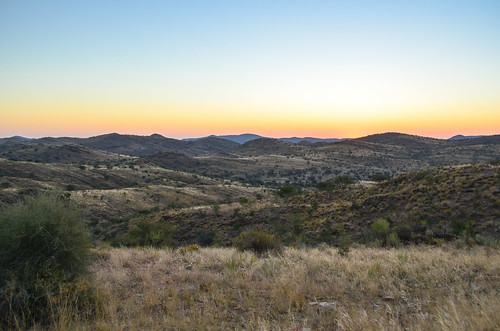
I stop after only 47 km, but kilometers of pain all day long. I couldn’t have done more. The 500 g macaroni package is the right amount of food I need for dinner.
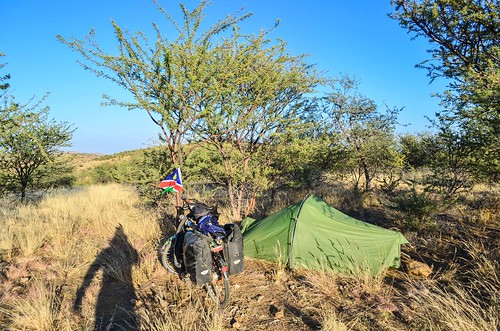
The following day is the same: up and down. I have been hoping since yesterday afternoon to find that “small shop right by the road” indicated by the road graders, despite the concept being outlandish: there can’t be any customer if a shop opened here. But since I really need to buy more food, I optimistically held on the hope. Why did the grading workers lied to me?
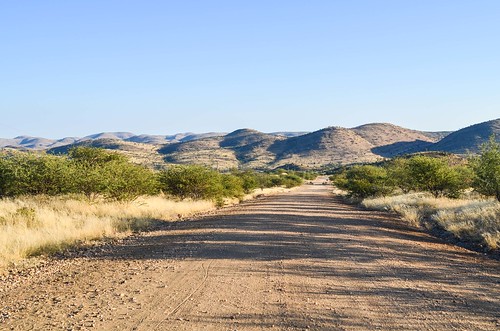

After 20 km, I am saved once again by road graders. The grading truck cannot take the Boshua pass, so two different teams are working from the two ends of the road. I really needed water when a grading trailer appeared up a hill. Perfect lucky timing! They carry gas for the machine and a large water tank. I hesitate to ask them for food, as another package of pasta would greatly help me, but they maybe have just enough for their several days of labor alone in the Khomashochland.
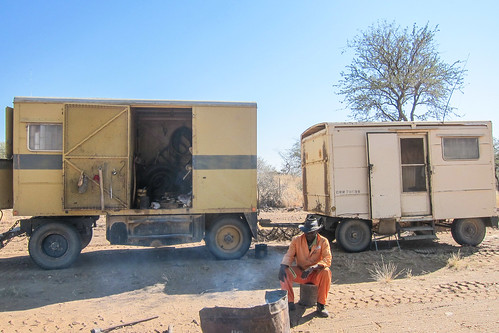
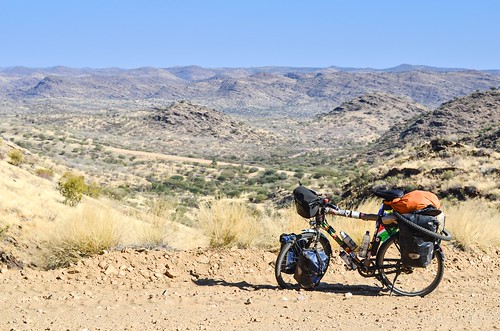
My legs are not too bad today, but while pushing the bike up, I notice something fishy on my front tire … a torn sidewall! With the inner tube popping out.

Today is Friday 13th. On this C28, a lot of things have gone wrong. I was already worrying about hyenas, food and water, the rear tire wear … and I “tried” not to be superstitious. But it didn’t work.
As I wrote earlier, the sidewalls of the Schwalbe tires of the Performance line are not good at all. As thin as paper. My rear tire sidewall is agonizing, but this time it’s the front one that got a cut, probably from a stone. It’s wiser to repair that right now before the tube bursts.

I have a spare tire, but I’d rather keep it for the rear, where the sidewall of the current tire is giving birth to a much bigger hole. So here I am, in the shade, looking at my stuff and wondering what I could use to patch this hole. It never happened to me before, and since the Schwalbe sidewalls are bulletproof for the right version (Evolution line), I never contemplated having to repair one.
At that time, I am blocking the part of road where the grader wants to go. The driver stops to see what’s my problem and says he’ll come back with a solution. It’s the third time these grading people are saving me …
I have superglue with me, and the grader driver brought with him a very thick old inner tube. We stick a piece inside my tire and hope it will hold on until Windhoek.
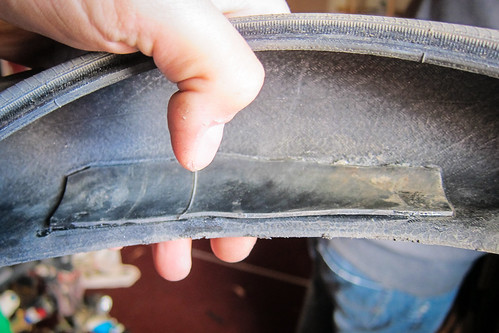
I am now moving on a gravel road being graded, and it makes things worse. Basically, the grader first softens the road surface and digs up large stones. Before the material is packed down, it remains a sea of soft sand with stones. So I keep pushing …
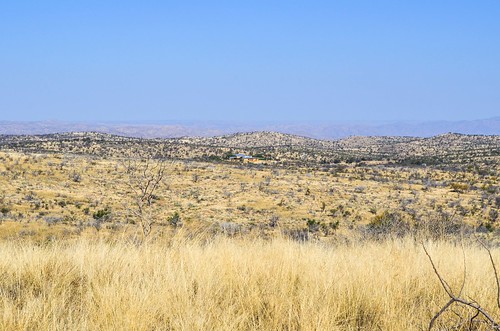


The scenery looks like Brandberg West, where the soil is a layer of seabed sediments pushed up in the air by tectonic shift. The Khomas highland is thus similar to a giant corrugated iron sheet, with more than 100 m between the bumps and the dents. It makes waves, so does the road.

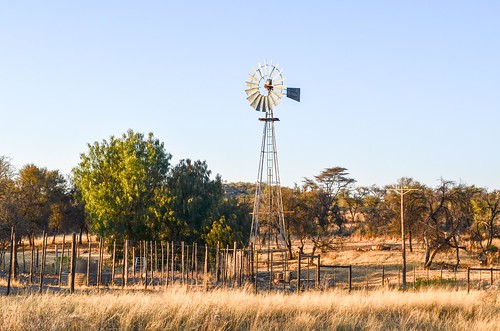
I see kudus and springboks from time to time until it’s night. My lunch was my emergency 165 g cookie package, which I have been carrying for a long time. This is the package of cookies I forget at the bottom of my pannier and I never eat, so that if I’m ever stuck somewhere, hungry, and have nothing else to eat, I’ll be happy to dig it out. It’s the second time of the whole journey I have to live off it.
My dinner is the very last food item of my whole luggage: a 500 g spaghetti package. This should refill my stomach that has been empty all day long, and give me enough energy until tomorrow lunch. My Namibian guide of accommodation features a campsite on this road, 20 km further. That’s the first business since I left Swakopmund five days ago, and is only 40 km from Windhoek.
Before setting up my tent, I take advantage of the last bits of daylight to unmount my tire and repair it preemptively. Indeed, the sidewalls are dead after 1500 km already.

I heard Windhoek was very cold, with temperatures down to 0°C, but it’s not too cold for me yet. Twelve degrees at worst.
Twenty kilometers until the food. And I must make the 60 kilometers left to Windhoek today. There is still some roller coaster pattern on the road, but not as bad as it was yesterday. Knowing I will eat good stuff in a few kilometers, I stop at the national monument of the Von Francois feste.
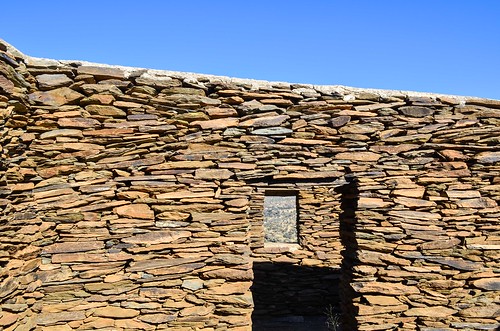
The fort consists of four rooms entirely made of stones. “When Major Curt von Francois, commander of the German Schutztruppe in German South West Africa, decided in 1890 to move his headquarters from Tsaobis to Windhoek, he had this fort built to serve as a halfway post between these two places. After the German troops had been established in Windhoek it became an outpost for the troops horses and oxen and later it also served as a so-called “Trockenposten” for soldiers who had imbibed too much.”


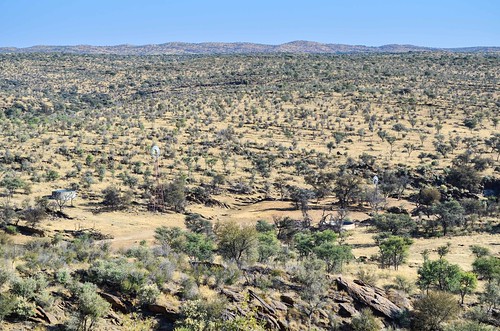
And a few turns later, that is another unusual sight standing right in front of me. A very large building looking like a haunted house.
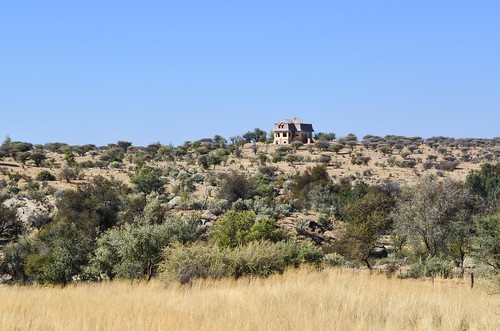
There is almost nothing man-made along the C28, hence a house like this one catches my attention. It is close to the road, so it’s worth going over the fence for a visit. The house is abandoned.

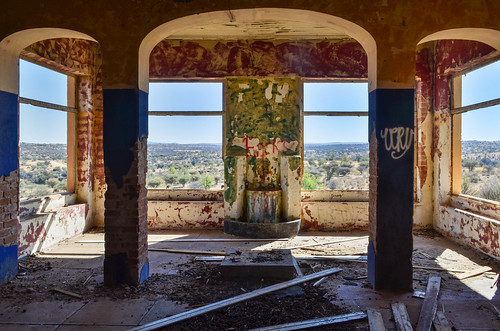
There is no one around to ask why it is so big, why it is in ruins, and what it was used for. It has a large fireplace in the central room, and a fountain in a living room with an astonishing panoramic view. While on site, I guess it must have been built for a high-ranking officer during the German colonization.
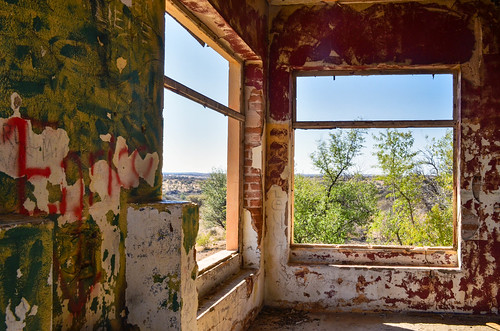
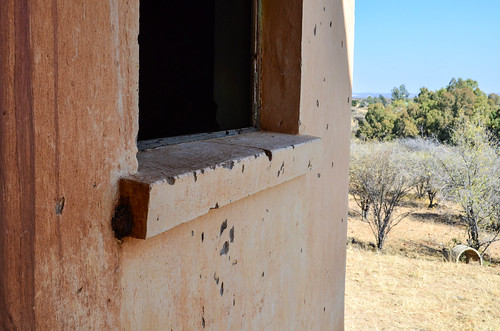
It’s only with internet, once in Windhoek, that I find out more about it. Namibia has so little buildings that these ruins even have a Wikipedia entry and more webpages (here and there) to tell its story.
It is called the Liebig house, originally built in 1911 under the German rule for the managers of the Liebig’s Extract of Meat Company (Lemco), that purchased 210’000 ha (almost the size of Luxemburg) of land in the Khomas highland. This company is the same that manufactures the Oxo stock cubes today. The house was called after the founder of Lemco, Baron Justus von Liebig, who invented meat extract.
“One of the managers who lived in the house was Alexander Scotland who served as a British secret agent in Namibia during the German period (and known for his cruel interrogation techniques). Scotland claims in his autobiography to have been given an appointment in the German Schutztruppe and to have been responsible for encouraging the guerrilla leader Johannes Christian to agree to a ceasefire with the Germans on December 23, 1906.
Tea parties would be held on the well-manicured garden, which featured a finely crafted statue, a flowing fountain and a beautifully carved fish with water cascading from the mouth into a pond of floating lilies and croaking frogs. Nowadays the walls of the lounge have been adorned with artistic prints and the former occupants can be imagined warming themselves in the winter around the large fireplace.”
The Germans were defeated by South Africa in 1915 during World War I, and in 1939, the South African government bought the land from the Liebig Company. There was enough real estate to build 65 farms and it was used to resettle farmers from the Union of South Africa at the end of World War II. The house was sold to in 1945 to a family who has left the country since then.
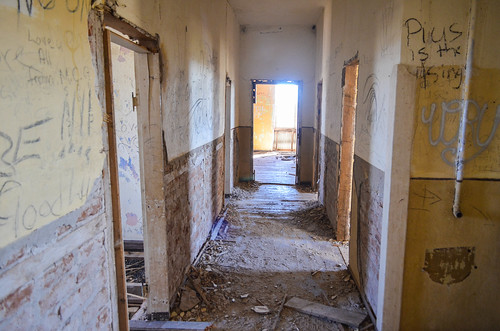

It was a nice visit, and it’s now lunch time, time for my second meal in two days. I reach the junction where the lodge/campsite should be … only to see a sign “Hochland nest 12 km —>”.
No way! The leaflet in my tourist guide clearly reads “ideally located at junction of C28 and D1418“. What a lie. And what a disappointment. This country is only made for cars for which an extra 24 km is nothing. I have been hoping and relying on a restaurant there, and the only thing I find is a sign saying the restaurant is 12 km further.
Instead, there is a church at this junction, and several buildings. No matter what it is, I will go and ask for food, I’m too hungry. These buildings are actually a large school with a hostel, catering for 230 kids. There are three ladies cooking in the kitchen and they kindly give me bread and sausages. Just enough energy to complete the 40 km until my destination.
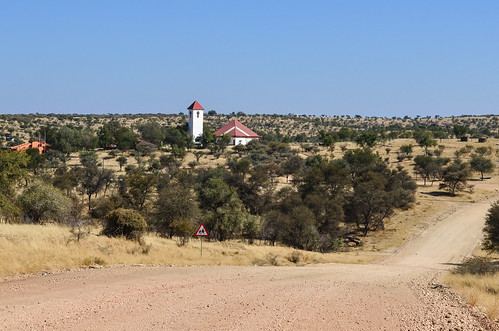
This is a school for the kids of all the farms (owners and workers) I crossed during my past 200 km. I don’t see any White kid there, either because they are picked up by their parents for the weekend, or rather because they are going to a better school in Windhoek.
It’s common for the (White) farmers of this area to stay alone during the weekdays while the wife and kids stay in the capital city, and return to the farm with food supplies on Friday evening. On the other hand, the Black kids have a harder life. A Namibian I met, named Henry, told me that when he happened to take this road three times within two days, each time he saw the same kids walking home for school holidays, barefoot, meaning that they have walked continuously for more than 24 hours on the C28.
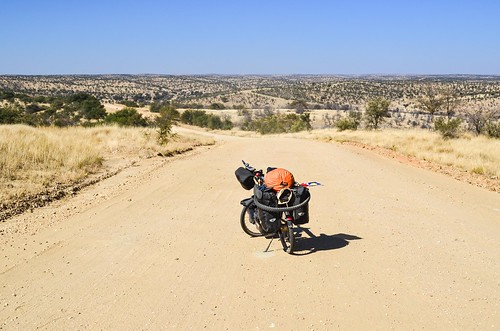
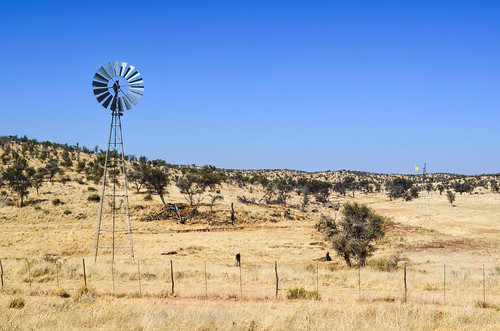

The tar reappears 30 km before Windhoek, and it’s mostly downhill. Yoohoo! I’m almost done with these tough six days on the C28. And very happy, as it was more masochistic than anything else.

The first part of the city I see is the township of Otjomuise. No concrete house there, but a whole hill shining from the corrugated iron rooftops and walls. I just went down from 2000 m to 1700 m and it feels much better to finally see houses instead of farmlands.


Windhoek is like Namibia: clean, quiet, slow, and relatively empty. The capital city of 400’000 looks nothing like Dakar, Monrovia, Accra, or Yaoundé. The traffic is organized and there are no street sellers. And it’s as clean as a Swiss city. Of course, there are still there dangerous taxi drivers pulling off anywhere and driving eyes on me instead of the road. But it only lasts 5 km until I reach the city center.
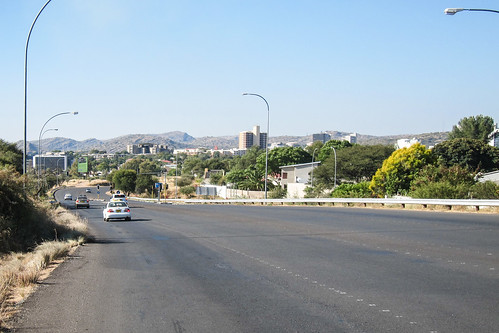

In Windhoek I meet Mark, a contact of Dave, who is preparing for his cycling trip. And while he kindly hosts me, I catch up with lots of good meat and internet.
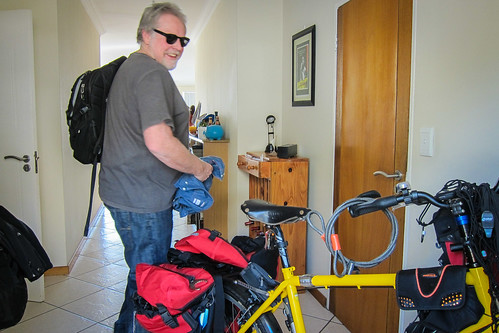
The priority in Windhoek is my visa and new tires. Mark brings me a set of Marathon Mondial Extreme from Cape Town. They are officially discontinued, but they are apparently the only Schwalbe in this part of the world from the Evolution line, with the strong sidewalls.
The Namibian visa extension is pretty straightforward. I asked for two extra months at the Home Affairs in the city center, and within three working days, for N$390 and a long queue, I have a new stamp in my passport. It has been already 80 days in the country for me.
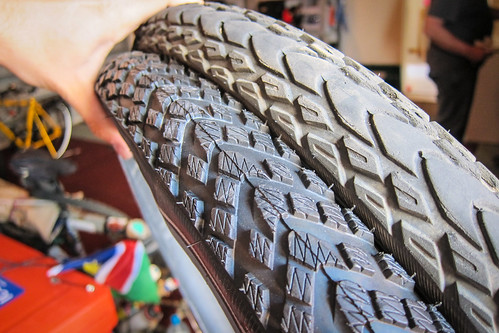
During my stay in Windhoek, we had time to watch the world cup in Brazil, to visit the Hilton bird’s eye view bar, Katutura, Chinatown, the Windhoek Metal Fest, and all of the five bike shops: Mannie’s bike mecca, CycleTech, Das Bikeshop, Bicycle wholesale, and Cymot 2nd floor. I have seen more brand products in any of these shops than along my road since I landed on the continent. But it’s more for MTB and road cycling, and doesn’t really suit the requirements of the cycle tourer. Nonetheless I take the opportunity to get the spokes of my rear wheel slightly adjusted.

If we ignore the suburbs, Windhoek looks more like a European city than an African one. There are too many supermarkets, malls, tourists, German flags, … I see the name of Pupkewitz everywhere, as often as things called after Sam Nujoma, and I finally get decent shoes, after three pairs of painful Chinese ones. With comfortable Keen shoes on my feet, it’s my biggest on-the-road investment of the journey after new tires, but I feel reborn.

I also pay a visit to the South African High Commission to see if I can get there a longer visa than the one delivered at the border, unsuccessfully. This year, much stricter immigration rules have been enforced in South Africa, and it’s not good for me.

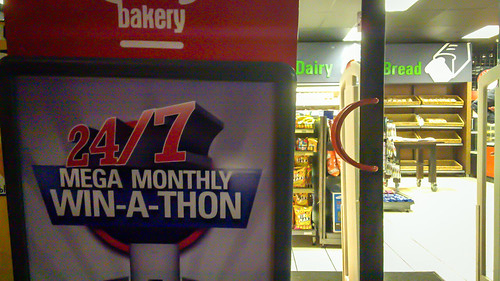
With my blog updated, my bike upgraded, my stomach spoilt, and France eliminated from the world cup, I am ready to start cycling south towards the Namib desert again. That’s when I learn that it’s not possible to enter South Africa with less than two blank passport pages, even for a land border. I thought I managed my visas perfectly and have just half a page left for the South African stamp, but it won’t work … and it makes me stay a few more days in the capital city to apply for a new passport.
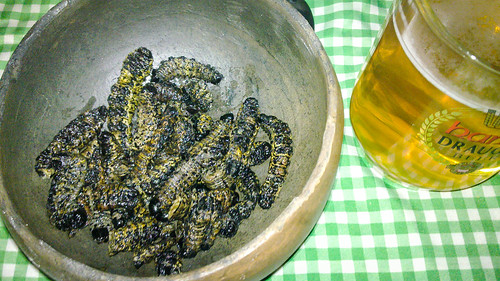







What an interesting article!
I am currently building myself my custom Touring bike that I have named SOMALAND.
Your article has just boosted my desire to hit the pedal Harder. However, not too hard yet as I am currently commuter cycle slow journey of 144kg travelling down to between 80kg and 90 before I can hit the pedal hard to Cape Town South Africa.
You have just boosted my will, and the photos and information therein are quite exceptional aas the read itslelf.
As I always say to myself, keep pedaling!